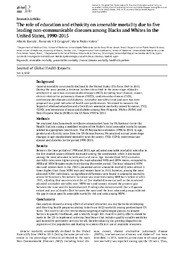Título :
The role of education and ethnicity on amenable mortality due to five
leading non-communicable diseases among Blacks and Whites in the
United States, 1990-2015 |
Autor :
BARCELO, ALBERTO 
Colugnati, Fernando 
Pastor-Valero, Maria  |
Editor :
Journal of Global Health Reports |
Departamento:
Departamentos de la UMH::Salud Pública, Historia de la Ciencia y Ginecología |
Fecha de publicación:
2020-06 |
URI :
https://hdl.handle.net/11000/30509 |
Resumen :
Background
General mortality consistently declined in the United States (US) from 1969 to 2013. During the same period, a decrease has been described in the percentage of deaths attributed to main non-communicable diseases (NCD) including heart disease, cancer, chronic obstructive pulmonary disease (COPD), cardiovascular disease (CVD), cerebrovascular diseases and diabetes. Amenable mortality trend and pace has been proposed as a good indicator of health care performance. We aimed to measure the impact of attained education and ethnicity on amenable mortality caused by cancer, CVD, COPD, cerebrovascular disease and diabetes among Non-Hispanic Whites (NHW) and Non-Hispanic Blacks (NHB) in the US from 1990 to 2015.
Methods
We analyzed data from death certificates downloaded from the US National Center for Health Statistics using a modified version of the Nolte’s list of amenable mortality causes related to appropriate health care. The US Population estimates (1990 to 2015) by age, gender and ethnicity came from the US Census Bureau. We analyzed annual percentage changes in age-standardized mortality rates for cancer, CVD, COPD, cerebrovascular disease and diabetes for the period 1990-2015.
Results
Between the time periods of 1990 and 2015, age-adjusted amenable mortality rates due to the five studied causes of death increased among the uneducated, while it decreased among the most educated in both sexes and races. Age-standardized NCD amenable mortality rates were higher among the least educated NHB and NHW males, compared to NHB and NHW females respectively during the entire period. The least educated NHW men and women born in the 1980’s presented cancer amenable mortality rates almost 3 times higher than those NHW men and women born in 1955; however, among the most educated NHW individuals, no significant differences were found in amenable mortality across birth cohorts. No notable variation was observed among NHB born before or after 1955, a finding that was consistent for all five studied diseases as well as the combined adjusted-amenable mortality rate. NHW men and women showed the greatest gap between the most and the least educated. Findings also demonstrated that a disparate cohort and year of death effect between the most and the least educated groups widened the gap in cause specific amenable mortality risk and ratio among NHW.
Conclusions
Our analysis showed a strong effect of attained education as a key factor for developing and directing health programs aiming to decrease NCD mortality among predominant US races. This reality calls for interventions targeting disadvantaged groups, to remove barriers to quality healthcare, and a healthy longer life. Assertive policy efforts should be made in the US to implement universal healthcare that includes quality curative medicine and innovative preventive services for all, thereby reducing the growing disparities in segments of the population and leading to a more efficient use of available resources.
|
Palabras clave/Materias:
amenable mortality
preventable mortality
chronic disease mortality
health disparities |
Área de conocimiento :
CDU: Ciencias aplicadas: Medicina |
Tipo de documento :
info:eu-repo/semantics/article |
Derechos de acceso:
info:eu-repo/semantics/openAccess |
DOI :
https://doi.org/10.29392/001c.13068 |
Aparece en las colecciones:
Artículos Salud Pública, Historia de la Ciencia y Ginecología
|

 La licencia se describe como: Atribución-NonComercial-NoDerivada 4.0 Internacional.
La licencia se describe como: Atribución-NonComercial-NoDerivada 4.0 Internacional.
.png)